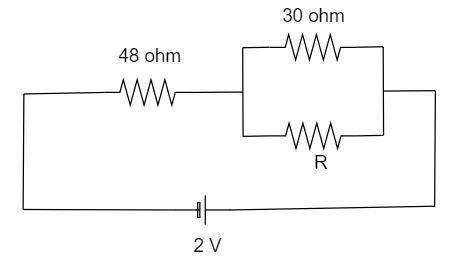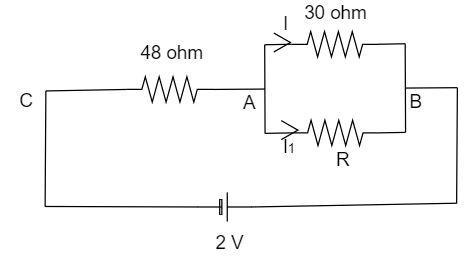
In the circuit shown, when $R$ is removed an additional resistance of $72\,$ ohm must be introduced in series with the battery in order to keep the current through $30\,$ ohm resistance unaltered. Hence $R$ is

Answer
142.2k+ views
Hint From the given circuit diagram, calculate the current, potential difference and the total current across each branch. Apply the formula below and substitute the calculated values to find the resistance of the resistor that is removed from the circuit.
Useful formula
The formula of the ohm’s law is given by
$V = IR$
Where $V$ is the potential difference, $I$ is the current flowing through the circuit and $R$ is the resistance.
Complete step by step solution
It is given that the
Resistor $R$ is removed from the circuit.
The additional resistor that must be connected to main the current, $72\,\Omega $

The value of the resistor, $R' = 30\,\Omega $
current $ = \dfrac{2}{{28 + 30 + 72}} = \dfrac{1}{{75}}\,A$
Voltage across $CA = $ Total voltage - voltage across $AB$
${V_{CA}} = 2 - \dfrac{2}{5} = \dfrac{8}{5}\,V$
Total current $ = \dfrac{8}{{5 \times 48}} = \dfrac{1}{{30}}\,A$
Since the resistor is connected in parallel, the potential difference developed across each resistor will be the same. Hence
$V = V'$
By substituting the ohms law in the above step,
$I'R = I\left( {30} \right)$
Rearranging the obtained equation, we get
$I' = \dfrac{{30I}}{R}$
Substituting the value of the resistance in the above equation, we get
$I' = \dfrac{{30}}{{75R}} = \dfrac{2}{{5R}}$
It is known that in a parallel circuit, the total current flows in the circuit will be equal to the sum of the currents flows in the individual branch.
$I = I + I'$
Substituting the values of the current in it,
$\dfrac{1}{{30}} = \dfrac{1}{{75}} + \dfrac{2}{{5R}}$
By simplify g the above equation by performing carious basic arithmetic operations,
$\dfrac{2}{{5R}} = \dfrac{1}{{50}}$
By further simplification of the above equation
$R = 20\,\Omega $
Hence the value of the resistance is obtained as $20\,\Omega $ .
Note
Remember that in a parallel circuit, the current flowing through the circuit will be the sum of the current flowing through each resistor and the voltage developed across each resistor will be the same. Hence the voltage across one resistor must be the subtraction of the other voltage with the total.
Useful formula
The formula of the ohm’s law is given by
$V = IR$
Where $V$ is the potential difference, $I$ is the current flowing through the circuit and $R$ is the resistance.
Complete step by step solution
It is given that the
Resistor $R$ is removed from the circuit.
The additional resistor that must be connected to main the current, $72\,\Omega $

The value of the resistor, $R' = 30\,\Omega $
current $ = \dfrac{2}{{28 + 30 + 72}} = \dfrac{1}{{75}}\,A$
Voltage across $CA = $ Total voltage - voltage across $AB$
${V_{CA}} = 2 - \dfrac{2}{5} = \dfrac{8}{5}\,V$
Total current $ = \dfrac{8}{{5 \times 48}} = \dfrac{1}{{30}}\,A$
Since the resistor is connected in parallel, the potential difference developed across each resistor will be the same. Hence
$V = V'$
By substituting the ohms law in the above step,
$I'R = I\left( {30} \right)$
Rearranging the obtained equation, we get
$I' = \dfrac{{30I}}{R}$
Substituting the value of the resistance in the above equation, we get
$I' = \dfrac{{30}}{{75R}} = \dfrac{2}{{5R}}$
It is known that in a parallel circuit, the total current flows in the circuit will be equal to the sum of the currents flows in the individual branch.
$I = I + I'$
Substituting the values of the current in it,
$\dfrac{1}{{30}} = \dfrac{1}{{75}} + \dfrac{2}{{5R}}$
By simplify g the above equation by performing carious basic arithmetic operations,
$\dfrac{2}{{5R}} = \dfrac{1}{{50}}$
By further simplification of the above equation
$R = 20\,\Omega $
Hence the value of the resistance is obtained as $20\,\Omega $ .
Note
Remember that in a parallel circuit, the current flowing through the circuit will be the sum of the current flowing through each resistor and the voltage developed across each resistor will be the same. Hence the voltage across one resistor must be the subtraction of the other voltage with the total.
Recently Updated Pages
Young's Double Slit Experiment Step by Step Derivation

Difference Between Circuit Switching and Packet Switching

Difference Between Mass and Weight

JEE Main Participating Colleges 2024 - A Complete List of Top Colleges

JEE Main Maths Paper Pattern 2025 – Marking, Sections & Tips

Sign up for JEE Main 2025 Live Classes - Vedantu

Trending doubts
JEE Main 2025 Session 2: Application Form (Out), Exam Dates (Released), Eligibility, & More

JEE Main Exam Marking Scheme: Detailed Breakdown of Marks and Negative Marking

JEE Main 2025: Derivation of Equation of Trajectory in Physics

Electric Field Due to Uniformly Charged Ring for JEE Main 2025 - Formula and Derivation

Learn About Angle Of Deviation In Prism: JEE Main Physics 2025

Electric field due to uniformly charged sphere class 12 physics JEE_Main

Other Pages
JEE Advanced Marks vs Ranks 2025: Understanding Category-wise Qualifying Marks and Previous Year Cut-offs

JEE Advanced 2025: Dates, Registration, Syllabus, Eligibility Criteria and More

JEE Advanced Weightage 2025 Chapter-Wise for Physics, Maths and Chemistry

Degree of Dissociation and Its Formula With Solved Example for JEE

JEE Main 2025: Conversion of Galvanometer Into Ammeter And Voltmeter in Physics

Dual Nature of Radiation and Matter Class 12 Notes: CBSE Physics Chapter 11




